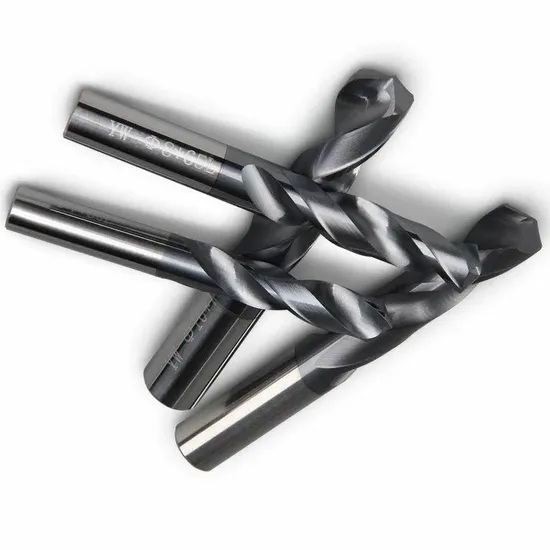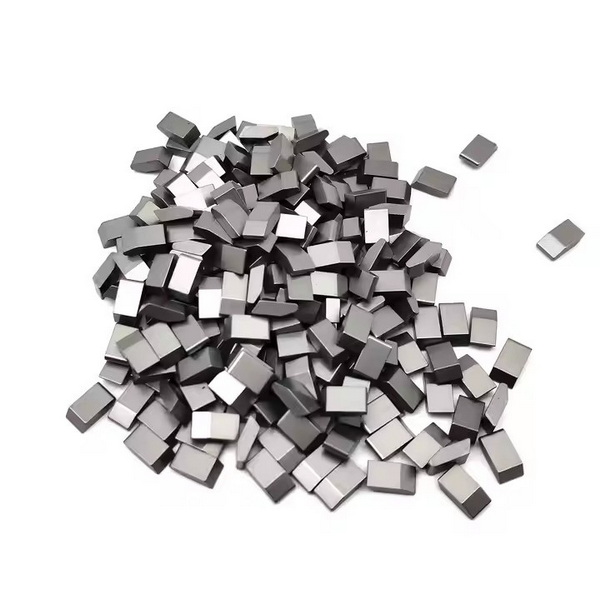Content Menu
● Understanding Tungsten Carbide
>> Properties of Tungsten Carbide
● Scratch Resistance of Tungsten Carbide: A Deeper Dive
● Practical Scenarios Leading to Scratches
● Mitigating Scratches: Maintenance and Care Tips
● The Resurfacing Myth: Can You Polish Out Scratches?
● Comparing Tungsten Carbide with Other Materials
● Conclusion
● FAQ
>> 1. Can tungsten rings get scratched?
>> 2. What causes scratches on tungsten carbide?
>> 3. How do I clean my tungsten ring without scratching it?
>> 4. Are colored or plated tungsten rings more prone to scratches?
>> 5. What should I do if my tungsten ring gets scratched?
● Citations:
Tungsten carbide is a material often lauded for its exceptional hardness and impressive resistance to scratches. Commonly found in applications ranging from exquisite jewelry to robust industrial tools and even critical military equipment, its reputation for durability precedes it. Yet, despite its seemingly impenetrable nature, the question remains: can you scratch tungsten carbide? This article will explore the intrinsic properties of tungsten carbide, thoroughly examine its scratch resistance capabilities, and provide practical advice for its care and use in everyday life.

Understanding Tungsten Carbide
Tungsten carbide is a composite material formed from tungsten and carbon atoms. This combination results in a dense, hard substance that boasts a ranking of 8 to 9 on the Mohs hardness scale. This scale is a universally recognized metric used to measure the scratch resistance of minerals, with diamond – the hardest known natural material – occupying the top spot at 10. The elevated hardness of tungsten carbide is what makes it an excellent candidate for applications demanding high levels of wear and tear resistance.
Properties of Tungsten Carbide
- Hardness: Tungsten carbide is among the hardest materials commercially available, second only to diamond. Its inherent hardness provides significant protection against scratching from softer materials.
- Strength: It possesses exceptionally high compressive strength, making it suitable for use in heavy-duty applications where resistance to deformation is critical.
- Rigidity: Tungsten carbide is significantly more rigid than steel. This attribute is crucial for its effectiveness in cutting tools, drill bits, and other industrial applications where minimal deflection under load is required.
- Impact Resistance: Despite its inherent hardness, tungsten carbide also offers good impact resistance. This allows it to withstand sudden shocks and impacts without fracturing or breaking easily.
- Thermal Stability: Tungsten carbide maintains its mechanical properties at high temperatures, making it suitable for applications involving high heat.
- Corrosion Resistance: Tungsten carbide is resistant to many types of corrosion, further enhancing its durability and longevity in various environments.
Scratch Resistance of Tungsten Carbide: A Deeper Dive
While tungsten carbide is known for its superior scratch resistance, it's important to clarify that it is not entirely impervious to scratches. The potential for scratching exists under certain conditions and through specific interactions with other materials.
- Contact with Harder Materials: Any material that surpasses tungsten carbide in hardness has the potential to leave a scratch. Diamond, with its Mohs hardness of 10, can easily scratch tungsten carbide. Similarly, certain ceramics, like boron carbide, possess comparable or superior hardness and can mar the surface of tungsten carbide.
- Force and Pressure: The amount of force or pressure applied during contact also plays a critical role. Even materials that are not inherently harder than tungsten carbide can cause surface damage if sufficient pressure is applied. For instance, abrasive materials like aluminum oxide, commonly found in sandpaper or grinding wheels, can scratch the surface of tungsten carbide if used aggressively.
- Composition and Grain Size: The composition of the specific tungsten carbide alloy and the grain size of the carbide particles can also influence its scratch resistance. Finer grain sizes generally offer improved wear resistance.
- Surface Finish: The surface finish of tungsten carbide can affect its scratch resistance. A highly polished surface may be more resistant to scratching than a rough surface.
- Plated Tungsten Items: Many tungsten carbide products, particularly in jewelry applications, are plated with other metals for aesthetic reasons. While the underlying tungsten carbide core retains its scratch resistance, the plating is often more vulnerable to scratches and wear.
Practical Scenarios Leading to Scratches
In everyday scenarios, various interactions can lead to visible scratches or wear on tungsten carbide items. Understanding these situations can help in taking preventive measures.
1. Jewelry Wear: Tungsten carbide rings and bracelets are popular for their durability; however, they are not immune to scratches. Engaging in activities that involve contact with abrasive surfaces, such as gardening, construction work, or even rigorous gym workouts, can lead to scratches.
2. Contact with Hard Objects: Accidental bumps or collisions with hard objects like concrete walls, metal surfaces, or ceramic tiles can potentially scratch tungsten carbide items. Even seemingly innocuous contact with keys or coins in a pocket or purse can gradually wear down the surface over time.
3. Industrial Applications: In industrial settings, tungsten carbide tools and components are often subjected to harsh conditions. Contact with abrasive materials, high-speed machining processes, and exposure to corrosive substances can contribute to surface wear and scratches.
4. Cleaning and Maintenance: Improper cleaning and maintenance practices can also lead to scratches. Using abrasive cleaning agents, scouring pads, or harsh chemicals can damage the surface of tungsten carbide items, especially those with plated finishes.
5. Accidental Damage: Dropping tungsten carbide items onto hard surfaces can cause chipping, cracking, or scratching. The risk is higher with items that have complex geometries or thin sections.

Mitigating Scratches: Maintenance and Care Tips
To maximize the longevity and maintain the aesthetic appearance of tungsten carbide products, it is important to follow some maintenance and care tips:
- Avoid Abrasive Environments: Be conscious of the environments in which you wear or use your tungsten carbide items. Minimize contact with rough or hard surfaces. Remove jewelry when engaging in activities that could potentially cause scratches.
- Use Soft Cleaning Materials: When cleaning tungsten carbide jewelry or tools, opt for soft, lint-free cloths and mild, non-abrasive cleaning solutions. Avoid using harsh chemicals or abrasive cleaners that can damage the surface. Warm water and mild soap are usually sufficient for cleaning.
- Gentle Cleaning Techniques: When cleaning, use gentle circular motions to wipe away dirt and grime. Avoid scrubbing vigorously, as this can increase the risk of scratching.
- Regular Inspections: Periodically inspect your tungsten carbide items for signs of wear, scratches, or other damage. Addressing minor issues early can prevent them from escalating into more significant problems.
- Proper Storage: Store tungsten carbide jewelry separately from other jewelry items to prevent scratches. Use individual pouches or compartments to protect each piece. For tools, use appropriate storage cases to prevent them from coming into contact with other tools or abrasive surfaces.
- Professional Polishing: If your tungsten carbide item has developed scratches, consider seeking professional polishing services. Skilled jewelers or technicians can use specialized polishing techniques to remove minor scratches and restore the surface to its original luster. However, it's important to note that deep scratches may not be completely removable.
- Avoid Harsh Chemicals: Avoid exposing tungsten carbide items to harsh chemicals, such as bleach, chlorine, or strong acids. These substances can damage the surface and affect its appearance.
- Consider Protective Coatings: For industrial applications, consider applying protective coatings to tungsten carbide tools or components. These coatings can enhance scratch resistance, reduce friction, and extend the lifespan of the items.
The Resurfacing Myth: Can You Polish Out Scratches?
While tungsten carbide is incredibly hard, it's a common misconception that scratches can easily be polished out at home. Unlike softer metals, tungsten carbide requires specialized equipment and techniques for polishing. Attempting to polish it yourself with household materials can often worsen the damage.
However, professional jewelers equipped with diamond-embedded polishing compounds and specialized tools can sometimes remove light surface scratches. The success of polishing depends on the depth and severity of the scratch. Deep scratches may be impossible to remove completely without altering the shape or integrity of the item.
Comparing Tungsten Carbide with Other Materials
To better appreciate the scratch resistance of tungsten carbide, it's helpful to compare it with other common materials used in jewelry and industrial applications:
| Material | Mohs Hardness | Scratch Resistance | Common Uses |
| Diamond | 10 | Excellent | Jewelry, cutting tools, abrasives |
| Tungsten Carbide | 8-9 | Very Good | Jewelry, cutting tools, wear parts |
| Titanium | 6 | Good | Jewelry, aerospace, medical implants |
| Stainless Steel | 5.5-6.5 | Moderate | Jewelry, cookware, industrial equipment |
| Gold (14K) | 2.5-3 | Poor | Jewelry |
| Silver | 2.5-3 | Poor | Jewelry, silverware |
As the table shows, tungsten carbide ranks high in terms of hardness and scratch resistance, making it a superior choice compared to many other materials.
Conclusion
In conclusion, while tungsten carbide is undoubtedly a hard and scratch-resistant material, it is not completely immune to scratches. Understanding its properties, recognizing potential sources of damage, and implementing proper care and maintenance practices can significantly prolong its lifespan and maintain its aesthetic appeal. By taking these measures, you can ensure that your tungsten carbide items continue to serve you well for years to come.

FAQ
1. Can tungsten rings get scratched?
Yes, while they are highly scratch-resistant due to their hardness, they can still be scratched by harder materials like diamonds, certain ceramics, or abrasive substances under sufficient pressure.
2. What causes scratches on tungsten carbide?
Scratches can occur due to contact with harder substances, exposure to abrasive materials, or through applying excessive force during everyday activities. Improper cleaning and maintenance can also contribute to scratches.
3. How do I clean my tungsten ring without scratching it?
Use a soft, lint-free cloth and a mild soap solution for cleaning. Avoid abrasive cleaners, scouring pads, or harsh chemicals that could damage the surface. Gently wipe the ring in circular motions and rinse thoroughly.
4. Are colored or plated tungsten rings more prone to scratches?
Yes, colored or plated rings may show scratches more easily because the coating is often more vulnerable to damage than the underlying tungsten carbide. Scratches on the plating can reveal the metal beneath, making them more noticeable.
5. What should I do if my tungsten ring gets scratched?
If your ring gets scratched, you can try gently polishing it with a soft cloth to remove any surface residue. For deeper scratches, it's best to seek professional refinishing services. Jewelers equipped with specialized tools and polishing compounds can sometimes remove or minimize scratches.
Citations:
[1] https://newmanbands.com/do-tungsten-rings-scratch-easily/
[2] https://carbideprocessors.com/pages/carbide-parts/tungsten-carbide-properties.html
[3] https://www.reddit.com/r/askscience/comments/x1el6/i_have_a_ring_made_of_tungsten_carbide_it_has/
[4] https://www.tungco.com/insights/blog/5-tungsten-carbide-applications/
[5] http://www.titaniumkay.com/tungsten-rings/can-you-scratch-a-tungsten-ring/
[6] https://www.carbide-usa.com/top-5-uses-for-tungsten-carbide/
[7] https://www.larsonjewelers.com/pages/does-tungsten-scratch
[8] https://en.wikipedia.org/wiki/Tungsten_carbide
















